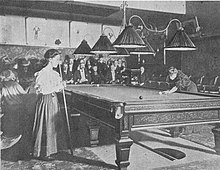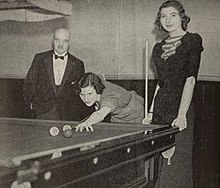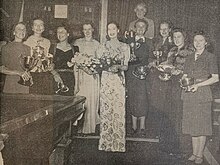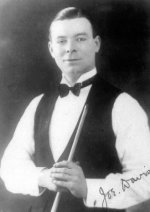
Joseph Davis was an English professional snooker and English billiards player. He was the dominant figure in snooker from the 1920s to the 1950s and has been credited with inventing aspects of the way the game is now played, such as break-building. With equipment manufacturer Bill Camkin, he drove the creation of the World Snooker Championship by persuading the Billiards Association and Control Council to recognise an official professional snooker championship in 1927. Davis won the first 15 championships from 1927 to 1946 and remains the only undefeated player in World Snooker Championship history. He scored the championship's first century break, in 1930.
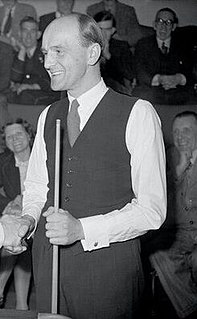
Walter Weir Wilson Donaldson was a Scottish professional snooker and billiards player. He contested eight consecutive world championship finals against Fred Davis from 1947 to 1954, and won the title in 1947 and 1950. Donaldson was known for his long potting and his consistency when playing, and had an aversion to the use of side. In 2012, he was inducted posthumously into the World Professional Billiards and Snooker Association's World Snooker Hall of Fame.
The 1927 World Snooker Championship was a snooker tournament held at various venues from 29 November 1926 to 12 May 1927. At the time, it was called the Professional Championship of Snooker but it is now recognised as the inaugural edition of the World Snooker Championship. The impetus for the championship came from professional English billiards player Joe Davis and billiard hall manager Bill Camkin, who had both observed the growing popularity of snooker, and proposed the event to the Billiards Association and Control Council. There were ten players who entered the competition, including most of the leading billiards players. The two matches in the preliminary round were held at Thurston's Hall in London, and the semi-finals final took place at Camkin's Hall in Birmingham. Venues for the quarter-finals were determined by the players involved, resulting in one match being held at Thurston's Hall, one at Camkin's Hall, and one each in Nottingham and Liverpool.
Allison Fisher is an English professional pool and former professional snooker player.

Tom Newman was an English professional player of English billiards and snooker. He was born Thomas Edgar Pratt in Barton-upon-Humber, Lincolnshire. He always appeared under the name Tom Newman when playing billiards or snooker and changed his name formally in 1919, shortly before his marriage that year.

Tom Reece was an English professional player of English billiards. He was six times runner-up in the professional billiards championship, now regarded as the world championship, losing three times to Melbourne Inman in finals from 1912 to 1914, and three times to Tom Newman in the 1921, 1924 and 1925 finals. He made the unofficial world's highest billiards break of 499,135 in 1907 using a cradle cannon technique shortly before it was banned from the sport. In 1927, his prowess with the pendulum stroke led to that also being banned from use in competition.
The World Billiards Championship is an international cue sports tournament in the discipline of English billiards, organised by World Billiards, a subsidiary of the World Professional Billiards and Snooker Association (WPBSA). In its various forms, and usually as a single competition, the title is one of the oldest sporting world championships, having been contested since 1870.
The 1930 World Snooker Championship, known at the time as the Professional Championship of Snooker, was a snooker tournament held between 17 March and 23 May 1930 at various venues in England, with the final taking place from 19 to 24 May at Thurston's Hall, London. Defending champion Joe Davis won the title for the fourth time by defeating Tom Dennis by 25 frames to 12 in the final.
The 1932 World Snooker Championship, known at the time as the Professional Championship of Snooker, was a professional snooker tournament that took place from 14 to 20 April 1932, with the final being held at Thurston's Hall in London, England. It is recognised as the sixth edition of the World Snooker Championship. The defending champion, Joe Davis from England, won the title for the sixth time by defeating New Zealander Clark McConachy by 30 frames to 19 in the final. The score when Davis achieved a winning margin was 25–18, with dead frames played afterwards. Davis set a new Championship record break of 99 in the 36th frame of the final. McConachy had become the first player from outside the British Isles to enter the championship. The only other participant was Tom Dennis, who was defeated 11–13 by McConachy in the semi-final at Skegness.
The 1947 World Snooker Championship was a professional snooker tournament. The final was held at the Leicester Square Hall in London, England, from 13 to 25 October. The semi-finals were completed in March, but the final was delayed due to building works at the venue, which had been bombed in October 1940. Walter Donaldson won the title by defeating Fred Davis by 82 frames to 63 in the final, although he reached the winning margin earlier, at 73–49. Davis made the highest break of the tournament with a 135 clearance in frame 86 of the final.
The 1948 World Snooker Championship was a professional snooker tournament that took place from 9 March to 1 May 1948. It was an edition of the World Snooker Championship first held in 1927. A qualifying event held from 1 to 13 December 1947 at Burroughes Hall in London was won by John Pulman, who joined seven other players in the main event.
Burroughes Hall was an important billiards and snooker venue in Soho Square, London from 1903 until it closed in 1967. The hall was in the premises of Burroughes & Watts Ltd., who had been at 19 Soho Square since 1836. Burroughes & Watts opened a new billiards saloon in 1903, known as the Soho Square Saloon. This was re-opened as the Soho Square Hall in 1904 and was renamed Burroughes Hall in 1913. In 1967, control of Burroughes & Watts Ltd. was taken over by a group of property developers. The assets included 19 Soho Square, which was demolished and replaced by a modern office block.
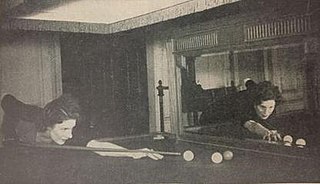
Joyce Gardner (1910–1981) was an English professional English billiards player. She was the Women's Professional Billiards Champion from 1931 to 1933, and from 1935 to 1938.

Ruth Harrison was an English snooker and billiards player. She won the Women's Professional Snooker Championship each year from its inception in 1934 to 1940, and again when it was next held, in 1948. She also won the Women's Professional Billiards Championship three times.
The Women's Professional Snooker Championship was a snooker tournament run from 1934 to 1950 by the Women's Billiards Association. The event was the world championship for female players during this time. Ruth Harrison was the most successful player, winning eight of the ten events. The event was later replaced by the World Women's Snooker Championship.

Thelma Carpenter was an English billiards and snooker player. She won the Women's Professional Billiards Championship three times, and the Women's Professional Snooker Championship once.
The Women's Billiards Association (WBA), founded in 1931 and based in London, United Kingdom, was the governing body for women's English billiards and snooker, and organised the Women's Professional Billiards Championship and Women's Professional Snooker Championship as well as amateur and junior competitions. The founding meeting was held on 13 May 1931 at the Women's Automobile and Sports Association. The meeting was chaired by Teresa Billington-Greig and appointed Viscountess Elibank as the first president and Mrs Longworth as the first chairman. The WBA ran amateur and professional billiards competitions starting from 1932, an amateur snooker tournament from 1933, and a professional snooker championship from 1934.

Margaret Lennan was a Scottish snooker and billiards player. She was runner-up in the 1936 Women's Professional Billiards Championship.
Eva Collins was an English snooker and billiards player. She was runner-up in the 1930 British Women's Billiards Championship, and in its successor tournament, the Women's Professional Billiards Championship in 1931.
The World Women's Billiards Championship is an English billiards tournament, first held in 1931 when organised by the cue sports company Burroughes and Watts then run from 1932 by the Women's Billiards Association (WBA). It is currently run under the auspices of World Billiards Ltd (WBL), a subsidiary company of the World Professional Billiards and Snooker Association.
